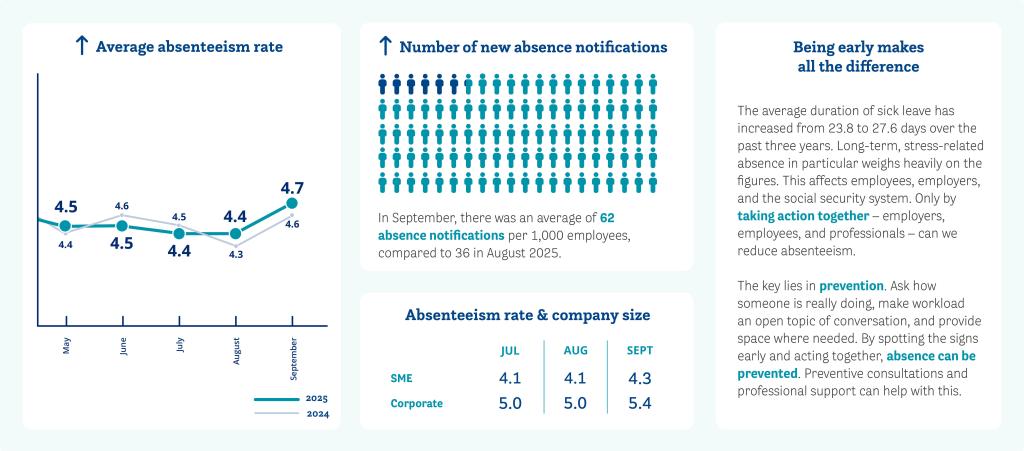Absence in September at highest level in years: particular increase in long-term absence

Flu-like symptoms cause a spike in absence but long-term absence is more serious
The upward trend in absence is clearly continuing this autumn. A record high was already evident in August this year, with absence at 4.4% compared to 3.5% in 2019. This is salient because the lowest number of absence notifications were received in August. In September this year, August’s record high was followed by a wave of short-term absence (less than six weeks) for flu-related reasons. “At 72%, that’s a significant increase in notifications for just one month,” says Redmer van Wijngaarden, Director of Medical Affairs at ArboNed. When a lot of employees are sick at the same time, it can create considerable challenges in the workplace.”
However, this does not explain the upward trend. A more structural problem underlies these temporary spikes and it is becoming more of an issue: long-term absence (more than six weeks). The increase in recent years is largely due to this type of absence, often caused by stress-related issues. This makes it more urgent for employers to take action but also more complex.
Stress-related issues dominate long-term absence
The average duration of sick leave increased from 23.8 to 27.6 days in three years. Short-term instances of employees reporting sick - e.g. for flu or colds - reduce the average but long-term absences push it up. The figure may also be slightly distorted because some short-term absence is not recorded. However, the picture is clear: long-term absence in particular has a major influence on the figures. In 2024, 8% of absences resulting from employees reporting sick lasted more than six weeks, while this small group was responsible for 75% of all absence days. Stress-related absence in particular is on the rise: 7% more than in 2023 and 36% more than five years ago.
Van Wijngaarden: "Stress-related issues are responsible for an increasing percentage of long-term absence. On average, employees who are absent because of these issues are not able to work their full quota of contracted hours for more than eight months; if employees are burnt out, a full return to work often takes even longer. This has a huge impact on organisations - especially SMEs - because replacements are difficult for them to arrange."
Early intervention makes all the difference
Rising absence figures are putting increasing pressure on employees, employers and the social security system. "You don't solve long-term absence with just one measure," Van Wijngaarden says. "It requires collaboration and a tailor-made approach. The key lies in prevention: recognising signs of excessive workload at an early stage, discussing the situation and taking immediate action. Employers can make a real difference by regularly asking employees how they really feel, making workload open to discussion and being flexible with tasks or planning, where necessary. Absence can also be prevented if employees take advantage of the preventive consultation hour offered by the occupational physician and seek professional help, e.g. via a company welfare officer or occupational psychologist. We will only be able to achieve a real reduction in long-term absence by taking early action together: the employer, employees and professionals."